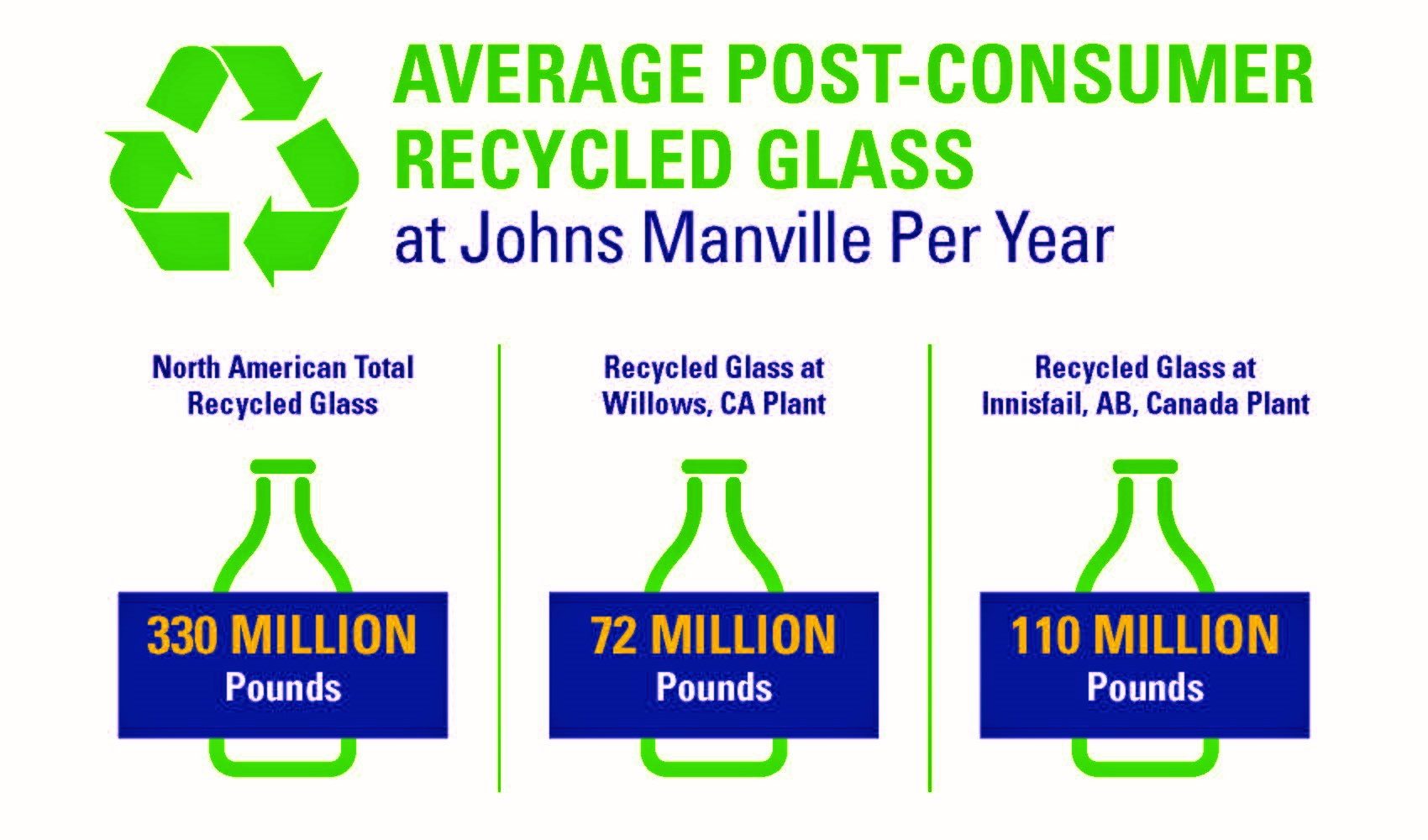Johns Manville has been working continuously to increase the volume of post-consumer recycled glass used at our plants. According to the Johns Manville 2021 Sustainability Report, over the last three years, JM has increased the average amount of recycled glass used in our fiberglass insulation products by 19 percent. Some other statistics around JM’s use of recycled content are shown in the graphic below.

Glass is an extremely desirable recycled material because it’s endlessly recyclable. Unlike many types of recyclable materials, including many plastics, glass can be recycled over and over without any loss in quality or purity. Another fact that makes glass a desirable material to work with is that it’s made from readily available domestic materials, such as sand, soda ash, limestone and “cullet,” the industry term for furnace-ready recycled glass.1 Not only is glass recycling interesting, it’s also important because it can help the environment in multiple ways. Here are three ways that recycling glass helps the environment.
#1 Reduces the amount of waste going to landfills
In 2020, JM set a goal to reduce by 10 percent the intensity of solid waste shipped to landfills by our Insulation Systems group. Achieving this goal involved looking at our manufacturing processes, revising and adopting new practices in our pallet use, recycling programs, general scrap processes, donation programs and more. JM was able to reduce the solid waste going to landfills by 11 percent, resulting in a reduction of over 13 million pounds of material.
Using recycled glass is also part of JM’s plan for sustainability because it contributes to the circular economy and reduces waste. Recycled glass comes primarily from the waste streams of large cities, with the majority coming from glass beverage bottles used in restaurants and other food service facilities. But consumers also contribute to the pool of recycled glass used by manufacturers.
JM facilities that make use of post-consumer recycled glass have cumulatively saved an estimated 13,100 tons of CO2 emissions, 69,000 cubic yards of landfill space and 7,800 megawatt hours of electricity.
#2 Recycled glass takes less energy to melt
A batch of glass can be made with various percentages of virgin raw materials and post-consumer recycled cullet. The first step in the glass manufacturing process is to melt these materials in a furnace. It takes an estimated 40% more energy to melt the virgin raw materials than it does to melt cullet. So when a batch is made from higher percentages of cullet, it helps save energy and reduce emissions.
JM facilities that make use of post-consumer recycled glass have cumulatively saved an estimated 13,100 tons of CO2 emissions and 7,800 megawatt hours of electricity. This helps JM meet its goal of reducing greenhouse gas emissions and conserving energy.
#3 Fiberglass insulation saves energy
Making homes and buildings more energy efficient by insulating them properly can help save energy. Many states and cities are adopting stricter building codes that require greater energy efficiency. According to a study by Energy Conservation Management, Inc., a typical pound of insulation saves on average 12 times as much energy in its first year in place as the energy used to produce it. Over its lifetime, one pound of insulation saves hundreds of times the energy used to make it.2 So the fiberglass insulation made using recycled glass continues to help the environment after it’s manufactured.
For more information
If you’d like to learn more about what JM is doing to increase recycling, reduce waste and save energy, check out the JM 2021 Sustainability Report: Building a Better Tomorrow. It provides enterprise-wide information on sustainability initiatives including economic, environmental, community and social impacts.
- Glass Packaging Institute, https://www.gpi.org/glass-recycling-facts#:~:text=Glass%20Facts,for%20furnace%2Dready%20recycled%20glass
- Green and Competitive - The Energy, Environmental, and Economic Benefits of Fiber Glass and Mineral Wool Insulation Products. https://insulationinstitute.org/wp-content/uploads/2016/02/GREEN.pdf (1996)

